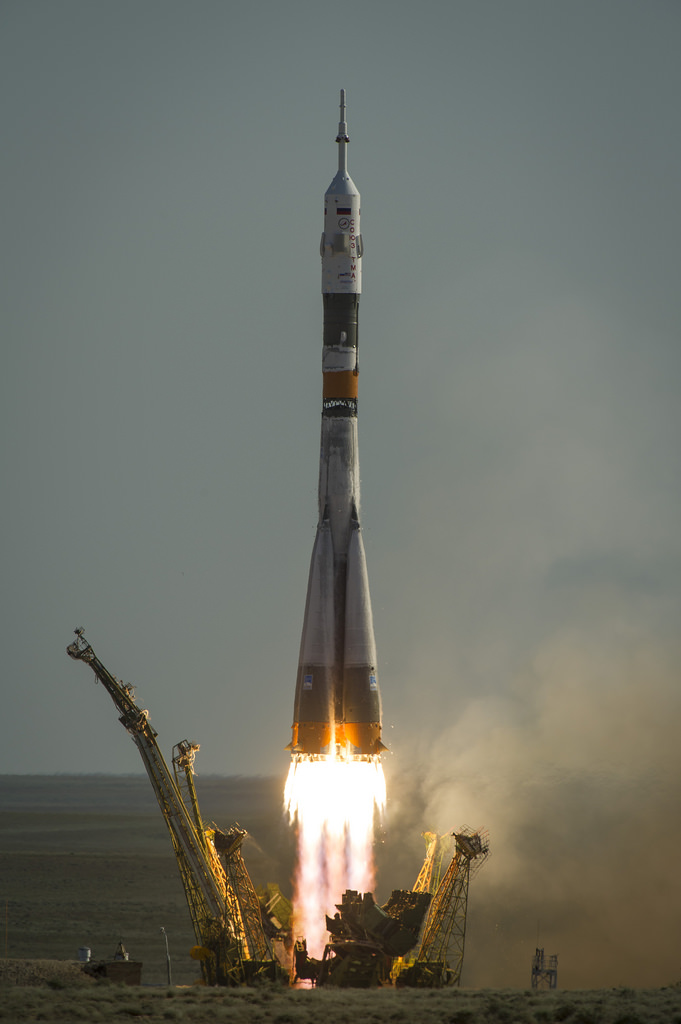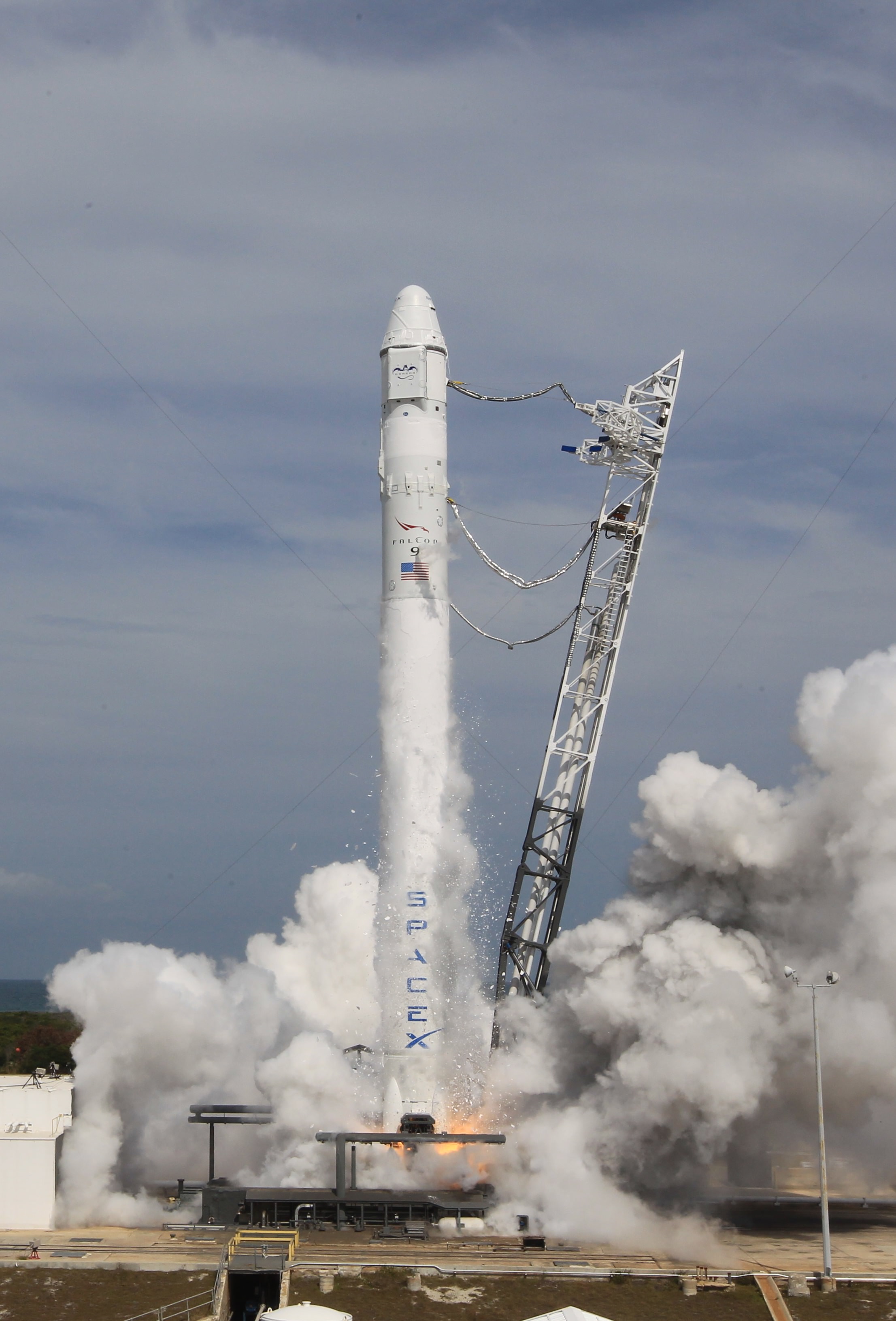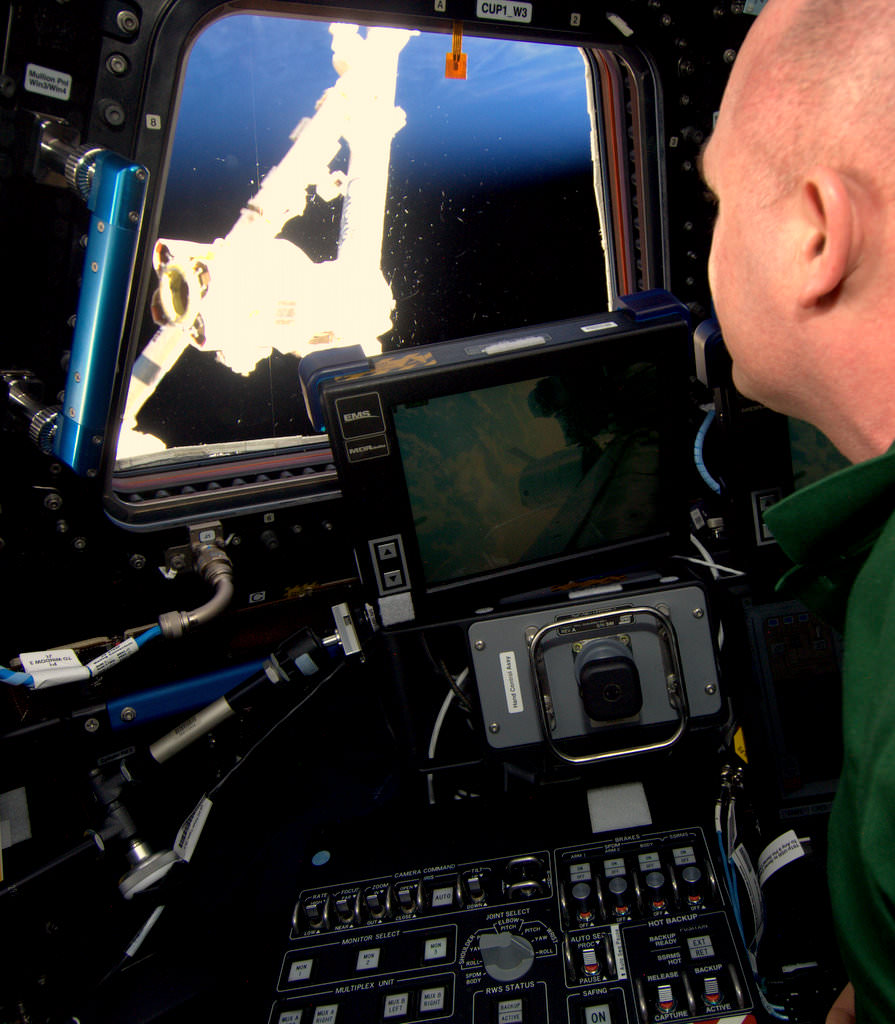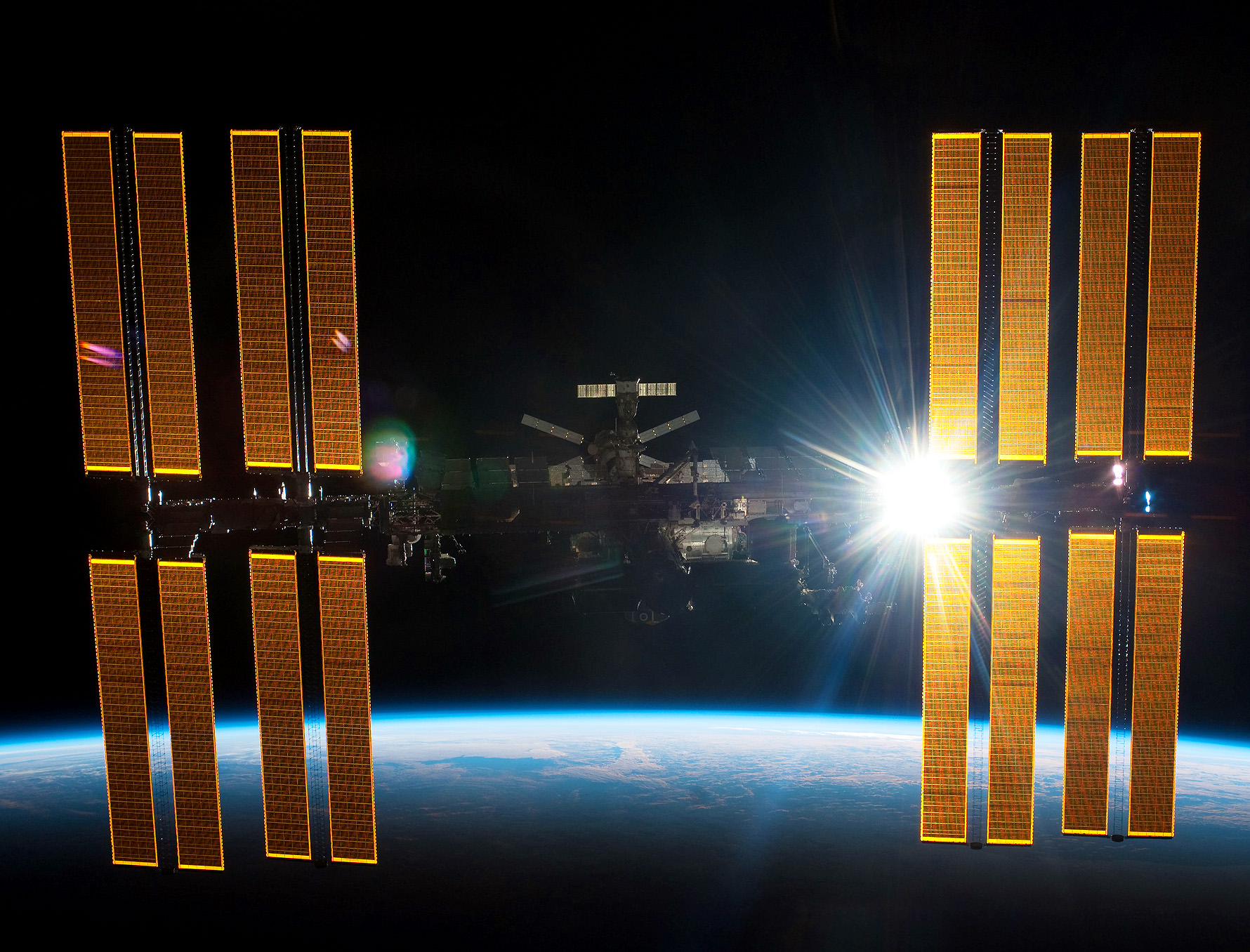The crew aboard the International Space Station is now back to a compliment of six. New Expedition 31 crew members Gennady Padalka, Joe Acaba and Sergei Revin docked and have now been welcomed on board the ISS after the hatches opened Thursday at 08:10 UTC (4:10 a.m. EDT). They docked to the Poisk module at 4:36 UTC (12:36 a.m. EDT) after a two day journey that began in Baikonur Cosmodrome, Kazakhstan aboard a Soyuz TMA-04M spacecraft. While they’ll be in space for about six months, the new crew members will get right to work preparing for the arrival of the first commercial cargo craft to the ISS. SpaceX’s Dragon is scheduled to launch at 08:55 UTC (4:55 a.m. EDT) this Saturday, May 19, with the Canadarm2 grappling Dragon on May 22, berthing it to the Harmony node.
Expedition 31 Blasts Off!
[/caption]
After a six-week delay, the crew of Expedition 31 successfully launched aboard a Soyuz TMA-04M rocket on Tuesday, May 15 at 0301 GMT (11:01 p.m. EDT May 14) from Russia’s historic Baikonur Cosmodrome, located in the steppes of Kazakhstan.
The rocket will deliver NASA astronaut Joe Acaba and Russian cosmonauts Gennady Padalka and Sergei Revin to the International Space Station. After a two-day journey, their Soyuz capsule will dock with the ISS at 11:38 p.m. CDT on Wednesday.
The launch was aired live by NASA HD TV. The full launch can be viewed below:
The crew was originally slated to launch on March 30, but problems with a pressure test forced a delay until a new Soyuz rocket could be brought into service. In the meantime ISS crew members Don Pettit, ESA astronaut Andre Kuipers and cosmonaut Oleg Kononenko have had the station to themselves since April 27.
The three new crew members will remain on Space Station until mid-September, serving as flight engineers under Expedition 31 commander Oleg Kononenko until July 1, when the current crew will depart and Padalka will assume command, marking the beginning of Expedition 32.
For more news on Expedition 31, visit NASA’s ISS website here. Also, you can follow NASA astronaut Joe Acaba on Twitter @AstroAcaba.
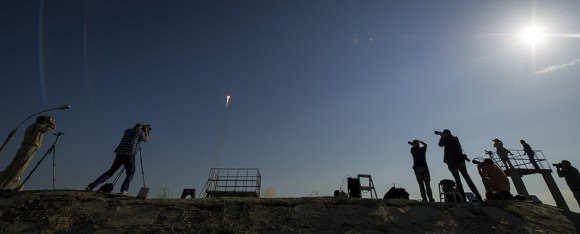
Video credit: NASA TV. Images: NASA/Bill Ingalls
SpaceX Dragon Launch Slides to May 19
[/caption]SpaceX has announced that the upcoming launch of the firms Falcon 9 and Dragon spacecraft on the commercial COTS 2 mission has been postponed to a new target date of no earlier than May 19 with a backup launch date of May 22.
On May 19, the Falcon 9 rocket would lift off on its first night time launch at 4:55 a.m. EDT (0855 GMT) from Space Launch Complex-40 on Cape Canaveral Air Force Station in Florida.
Two launch opportunities had been available this week on May 7 and May 10, following the most recent slip from April 30.
SpaceX managers made the decision – in consultation with NASA – to delay the COTS 2 launch in order to complete further highly critical testing and verifications of all the flight software requirements for the Dragon spacecraft to safely and successfully carry its mission of rendezvousing and docking with the International Space Station (ISS).
“SpaceX and NASA are nearing completion of the software assurance process, and SpaceX is submitting a request to the Cape Canaveral Air Force Station for a May 19th launch target with a backup on May 22nd,” said SpaceX spokesperson Kirstin Grantham.
“Thus far, no issues have been uncovered during this process, but with a mission of this complexity we want to be extremely diligent.”
May 10 was the last window of opportunity this week because of the pending May 14 blast off of a new Russian Soyuz TMA-04M capsule from the Baikonur Cosmodrome in Kazakhstan with three fresh crew members bound for the ISS which will restore the outpost to a full crew complement of 6 human residents.
The Falcon 9 and Dragon can only be launched about every three days.
The purpose of Dragon is to carry supplies up to and back from the ISS. Dragon is a commercial spacecraft developed by SpaceX and designed to replace some of the cargo resupply functions previously conducted by NASA’s fleet of prematurely retired Space Shuttle orbiters. At this moment the US has zero capability to launch cargo or crews to the ISS.
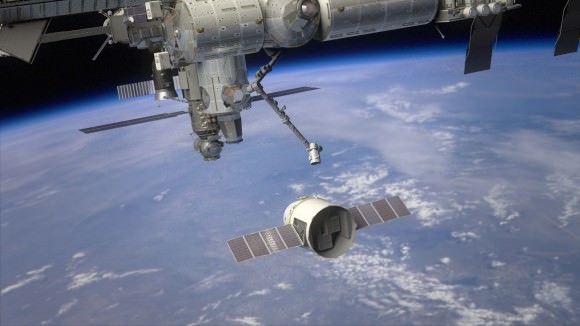
In response to the SpaceX announcement, NASA issued the following statement from from William Gerstenmaier, associate administrator for Human Exploration and Operations at the agency’s Headquarters in Washington:
“After additional reviews and discussions between the SpaceX and NASA teams, we are in a position to proceed toward this important launch. The teamwork provided by these teams is phenomenal. There are a few remaining open items, but we are ready to support SpaceX for its new launch date of May 19.”
SpaceX is under contract with NASA to conduct twelve resupply missions to the ISS to carry cargo back and forth for a cost of some $1.6 Billion.
Dragon is loaded with nearly 1200 pounds of non-critical cargo such as food and clothing on this flight.
The COTS 2 mission has been repeatedly delayed since the originally planned target of mid-2011 when SpaceX requested that the COTS 2 and 3 flights be combined into one mission to save time. The first Dragon docking to the ISS was initially planned for the COTS 3 mission.
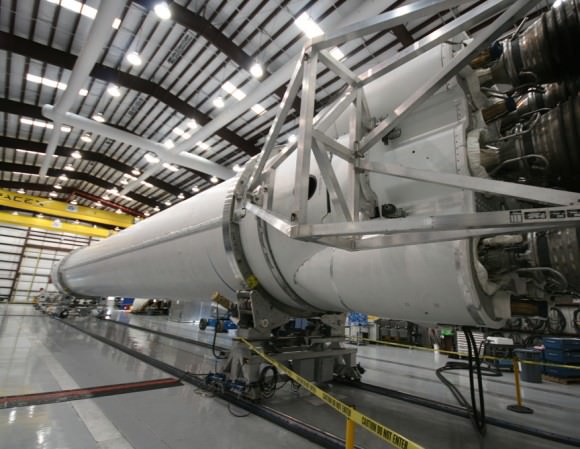
See Soundwaves in Space
What fun! The science officer aboard the International Space Station, Don Pettit, does some simple but amazing science in his series, Science Off the Sphere. In his latest video, Pettit allows us to ‘see’ sound waves in space.
“I’m amazed at how much fun you can with something as simple as a set of speakers from your laptop computer and a splash of water,” said Pettit who added that he wanted to see how sound waves would affect water droplets “without the complications of gravity.”
Make sure you watch to the very end to rock out with Pettit and see the variations between the woofer and tweeter on the speaker and how the different sounds affect the water drops.
View from Orbit of a Huge White Sands Dust Storm
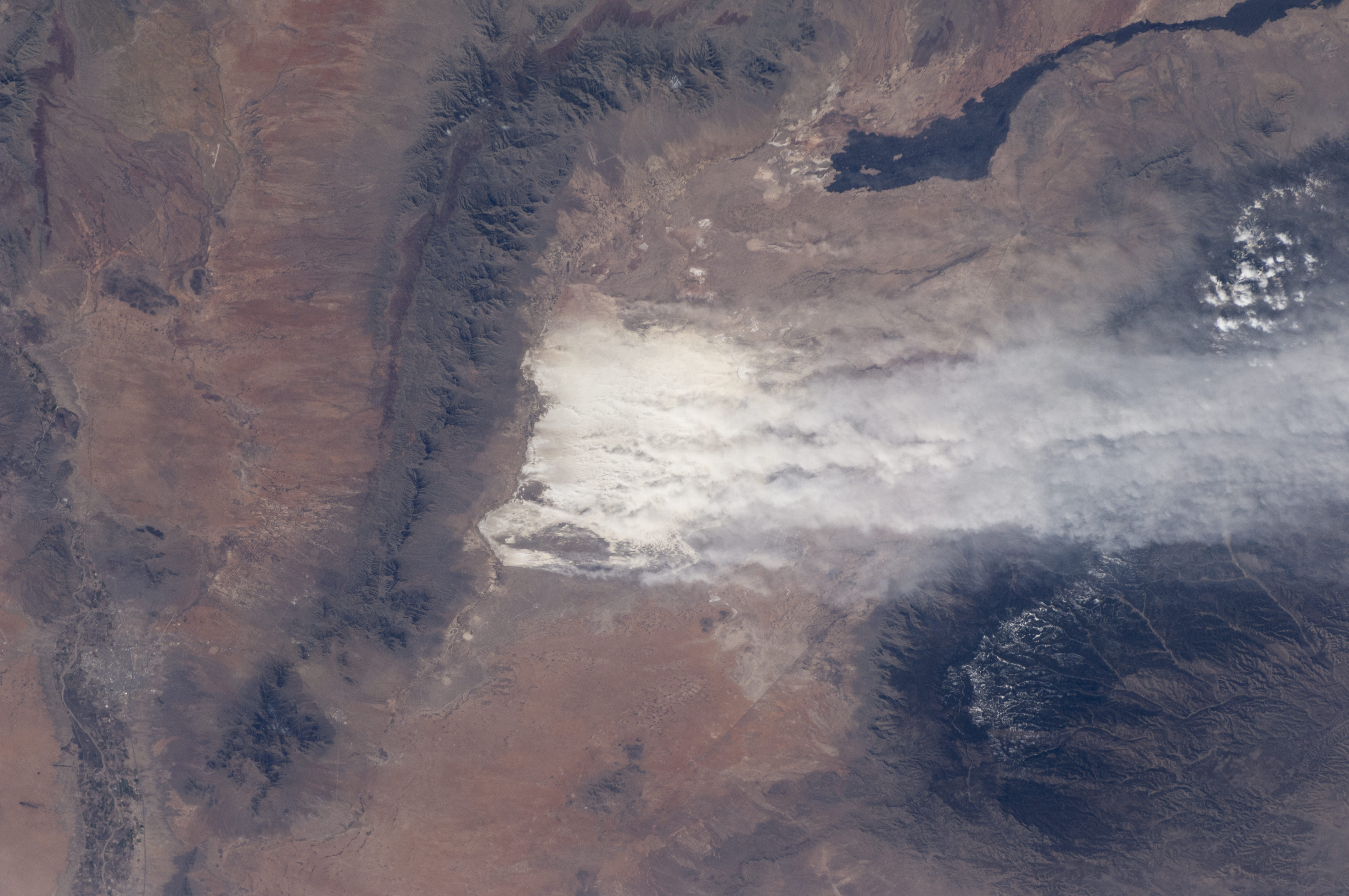
[/caption]
It’s clear from this image of why a region in New Mexico, USA is called ‘White Sands.’ The dust plumes in this photograph taken by an astronaut on board the International Space Station show a dust storm in the White Sands National Monument. But this is a huge dust storm. The white dust plumes stretch across more than 120 kilometers (74 miles).
Caused by winds that channel the dust through a low point in the mountains, the vigorous winds are lifting dust particles from the valley floor to more than 1200 meters over the mountains. The Moderate Resolution Imaging Spectroradiometer (MODIS) on NASA’s Aqua satellite also captured a wider, regional view of the same storm on the same day.
The sand dunes of this national monument are white because they are composed of gypsum, a relatively rare dune-forming mineral. The dunes’ brilliance, especially contrasted against the nearby dark mountain slopes, makes them easily identifiable to orbiting astronauts. The white speck of the dunes was even visible to the Apollo astronaut crews looking back at Earth on the way to the Moon.
Source: NASA Earth Observatory
SpaceX Launch to Space Station Delayed
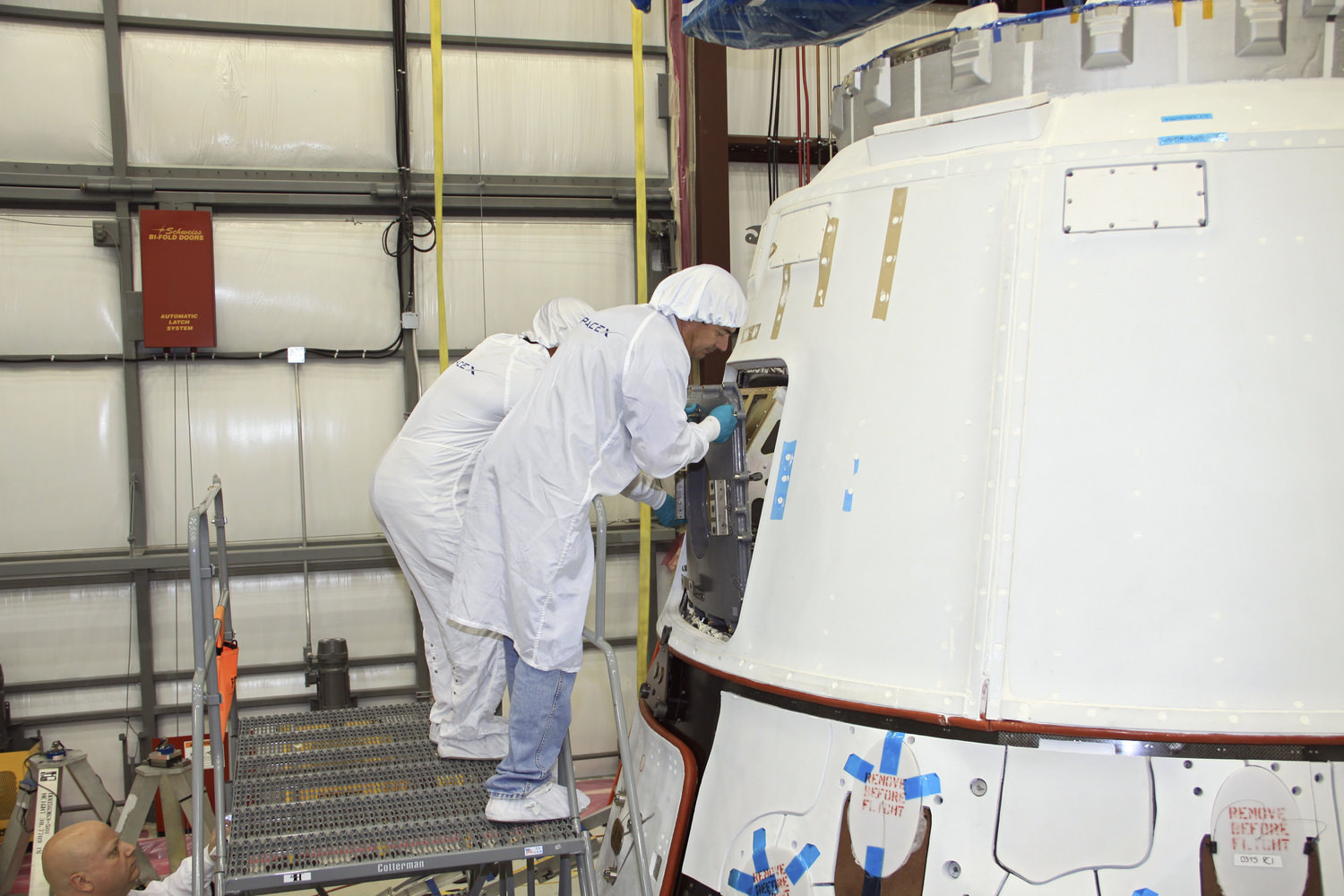
[/caption]
The historic flight of the first commercial transport to the International Space Station will have to wait at least another week. “After reviewing our recent progress, it was clear that we needed more time to finish hardware-in-the-loop testing and properly review and follow up on all data,” SpaceX said in a statement today. “While it is still possible that we could launch on May 3rd, it would be wise to add a few more days of margin in case things take longer than expected. As a result, our launch is likely to be pushed back by one week, pending coordination with NASA.”
And so, the launch which was going to take place on April 30 is now pushed back to no earlier than May 7. A static fire test of the Falcon 9 rocket that SpaceX had hoped to do today was slipped to the 27th, making the all the preparations for the launch next Monday a tight squeeze.
When launched, the Dragon will arrive at the ISS one to three days later and once there, Dragon will begin the demonstrations related to the Commercial Orbital Transportation Services Phase 2 agreements (COTS 2) to show proper performance and control in the vicinity of the ISS, while remaining outside the Station’s safe zone. Then, if all goes well, Dragon will receive approval to begin the COTS 3 activities, where it will gradually approach within a few meters of the ISS, allowing astronauts to reach out and grapple Dragon with the Station’s robotic arm and then maneuver it carefully into one of the docking ports.
‘Seeing’ Cosmic Rays in Space
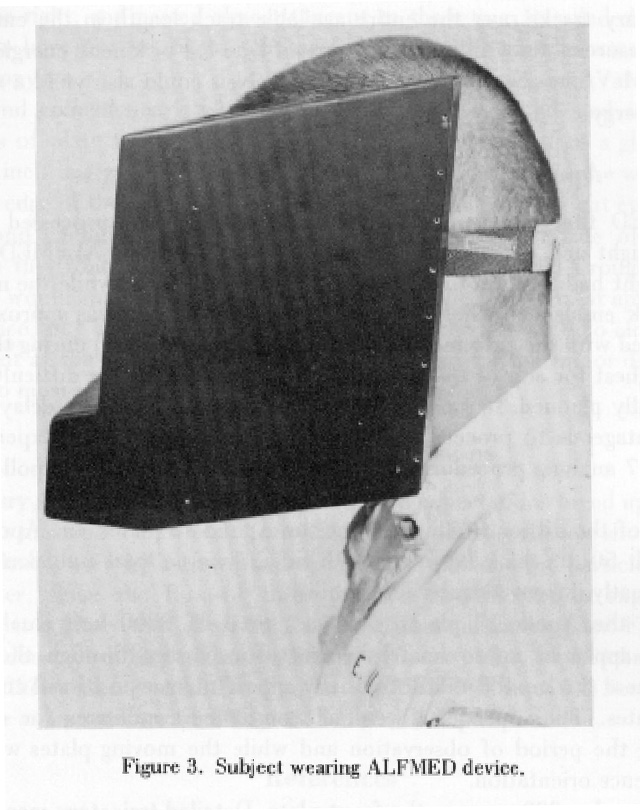
Astronauts have long reported the experience of seeing flashes while they are in space, even when their eyes are closed. Neil Armstrong and Buzz Aldrin both reported these flashes during the Apollo 11 mission, and similar reports during the Apollo 12 and 13 missions led to subsequent Apollo missions including experiments specifically looking at this strange phenomenon. These experiments involved blindfolding crewmembers and recording their comments during designated observation sessions, and later missions had a special device, the Apollo Light Flash Moving Emulsion Detector (ALFMED), which was worn by the astronauts during dark periods to record of incidents of cosmic ray hits.
It was determined the astronauts were ‘seeing’ cosmic rays zipping through their eyeballs. Cosmic rays are high-energy charged subatomic particles whose origins are not yet known. Fortunately, cosmic rays passing through Earth are usually absorbed by our atmosphere. But astronauts outside the atmosphere can find themselves “seeing things that aren’t there,” wrote current International Space Station astronaut Don Pettit, who told about his experience of seeing these flashes on his blog:
“In space I see things that are not there. Flashes in my eyes, like luminous dancing fairies, give a subtle display of light that is easy to overlook when I’m consumed by normal tasks. But in the dark confines of my sleep station, with the droopy eyelids of pending sleep, I see the flashing fairies. As I drift off, I wonder how many can dance on the head of an orbital pin.”
In a report on the Apollo experiment, astronauts described the types of flashes they saw in three ways: the ‘spot’, the ‘streak’, and the ‘cloud’; and all but one described the flashes as ‘white’ or ‘colorless.’ One crewmember, Apollo 15 Commander David Scott, described one flash as “blue with a white cast, like a blue diamond.”
Pettit described the physics/biology of what takes place:
“When a cosmic ray happens to pass through the retina it causes the rods and cones to fire, and you perceive a flash of light that is really not there. The triggered cells are localized around the spot where the cosmic ray passes, so the flash has some structure. A perpendicular ray appears as a fuzzy dot. A ray at an angle appears as a segmented line. Sometimes the tracks have side branches, giving the impression of an electric spark. The retina functions as a miniature Wilson cloud chamber where the recording of a cosmic ray is displayed by a trail left in its wake.”
Pettit said that the rate or frequency at which these flashes are seen varies with orbital position.
“There is a radiation hot spot in orbit, a place where the flux of cosmic rays is 10 to 100 times greater than the rest of the orbital path. Situated southeast of Argentina, this region (called the South Atlantic Anomaly) extends about halfway across the Atlantic Ocean. As we pass through this region, eye flashes will increase from one or two every 10 minutes to several per minute.

During the Apollo missions, astronauts saw these flashes after their eyes had become dark-adapted. When it was dark, they reported a flash every 2.9 minutes on average. Only one Apollo crewmember involved in the experiments did not report seeing the phenomenon, Apollo 16’s Command Module Pilot Ken Mattingly, who stated that he had poor night vision.
These cosmic rays don’t just hit people, but things in space, too, and sometimes cause problems. Pettit wrote:
“Free from the protection offered by the atmosphere, cosmic rays bombard us within Space Station, penetrating the hull almost as if it was not there. They zap everything inside, causing such mischief as locking up our laptop computers and knocking pixels out of whack in our cameras. The computers recover with a reboot; the cameras suffer permanent damage. After about a year, the images they produce look like they are covered with electronic snow. Cosmic rays contribute most of the radiation dose received by Space Station crews. We have defined lifetime limits, after which you fly a desk for the rest of your career. No one has reached that dose level yet.”
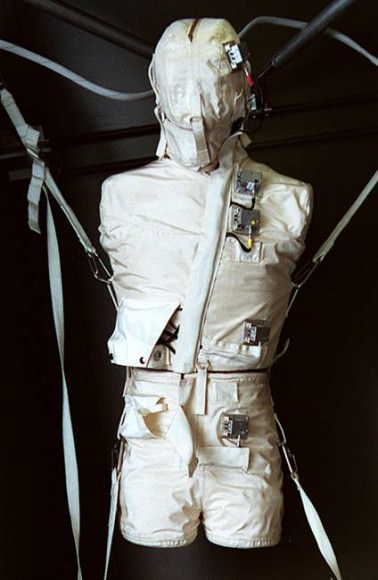
There are experiments on board the ISS to monitor how much radiation the crew is receiving. One experiment is the Phantom Torso, a mummy-looking mock-up of the human body which determines the distribution of radiation doses inside the human body at various tissues and organs.
There’s also the Alpha Magnetic Spectrometer experiment, a particle physics experiment module that is mounted on the ISS. It is designed to search for various types of unusual matter by measuring cosmic rays, and hopefully will also tell us more about the origins of both those crazy flashes seen in space, and also the origins of the Universe.
A tall order!
How to Capture a Dragon in Space
[/caption]
With the upcoming historic launch of the SpaceX Dragon capsule to the International Space Station, astronauts in orbit have been getting ready for the first commercial spacecraft that will bring supplies to the station. Astronauts Don Pettit and André Kuipers will be manually capturing and berthing the Dragon capsule, using the ISS’s Canadarm2. Originally, current station commander Dan Burbank was to be the main arm operator, but with the delay in Dragon’s launch (it was originally scheduled for February 2012), Burbank will already be back on Earth by the time Dragon reaches the station, currently scheduled for May 3. So now, Pettit and Kuipers have had to take over the duties and learn their new jobs while in space. Without the high-tech simulators that NASA has at Johnson Space Center, how do the astronauts prepare and practice for this important event?
“We have a really neat capability here on Station,” Pettit said during a press conference last week. “I have it set up all the time, so I wake up in the morning and have a bag of coffee in my mouth and a cinnamon scone in one hand and flying the simulator with the other.”
The crew actually has two ways to practice for Dragon’s arrival.
“One is actually flying (practicing with) the Canadarm, which is the world’s best trainer,” Pettit said, “and then on station we have two space station computers which double as an Arm simulator, and it has a full set of the Arm hand controllers – the setup, which we call Robot allows us to fly track and capture trajectories just as if we were in the simulators in Houston.”
Initially Burbank would have been the main arm officer, with Pettit and Kuipers assisting. Now, Pettit and Kuipers will have to complete the task themselves, with the two of them doing all the things that the three of them were originally trained to do.
For the capture and berthing, Pettit and Kuipers will be in the Cupola, with Pettit as prime operator and Kuipers as second arm operator. “We will have arm operation in the (Destiny) lab as a ‘hot backup’ just in case of contingencies, and we can activate it there if needed.”
The two astronauts will use the Station’s Canadarm2 to first grab the spacecraft and then maneuver it into place to mate with the Harmony module’s Earth-facing docking port.
Pettit said the on-orbit training has been invaluable. “It is really good to have that type of capability,” he said.
The following animation from the Canadian Space Agency shows just how complex it is to capture a Dragon in space.
SpaceX’s launch and Dragon’s arrival will be the premiere test flight in NASA’s new strategy to resupply the ISS with privately developed rockets and cargo carriers under the Commercial Orbital Transportation Services (COTS) initiative. Even though it is technically a est flight, NASA isn’t about to pass up an opportunity to send supplies to the station. Dragon will carry about nearly 521 kg (1,150 pounds) of cargo, mainly food and some spare parts for the ISS. When Dragon departs, the station crew will load nearly 680 kg (1,500 pounds) of cargo to be sent back to Earth, since the Dragon capsule won’t burn up in the atmosphere like other supply ships — it will be recovered in the ocean.
Beautiful Image: The Moon as Seen from the Space Station
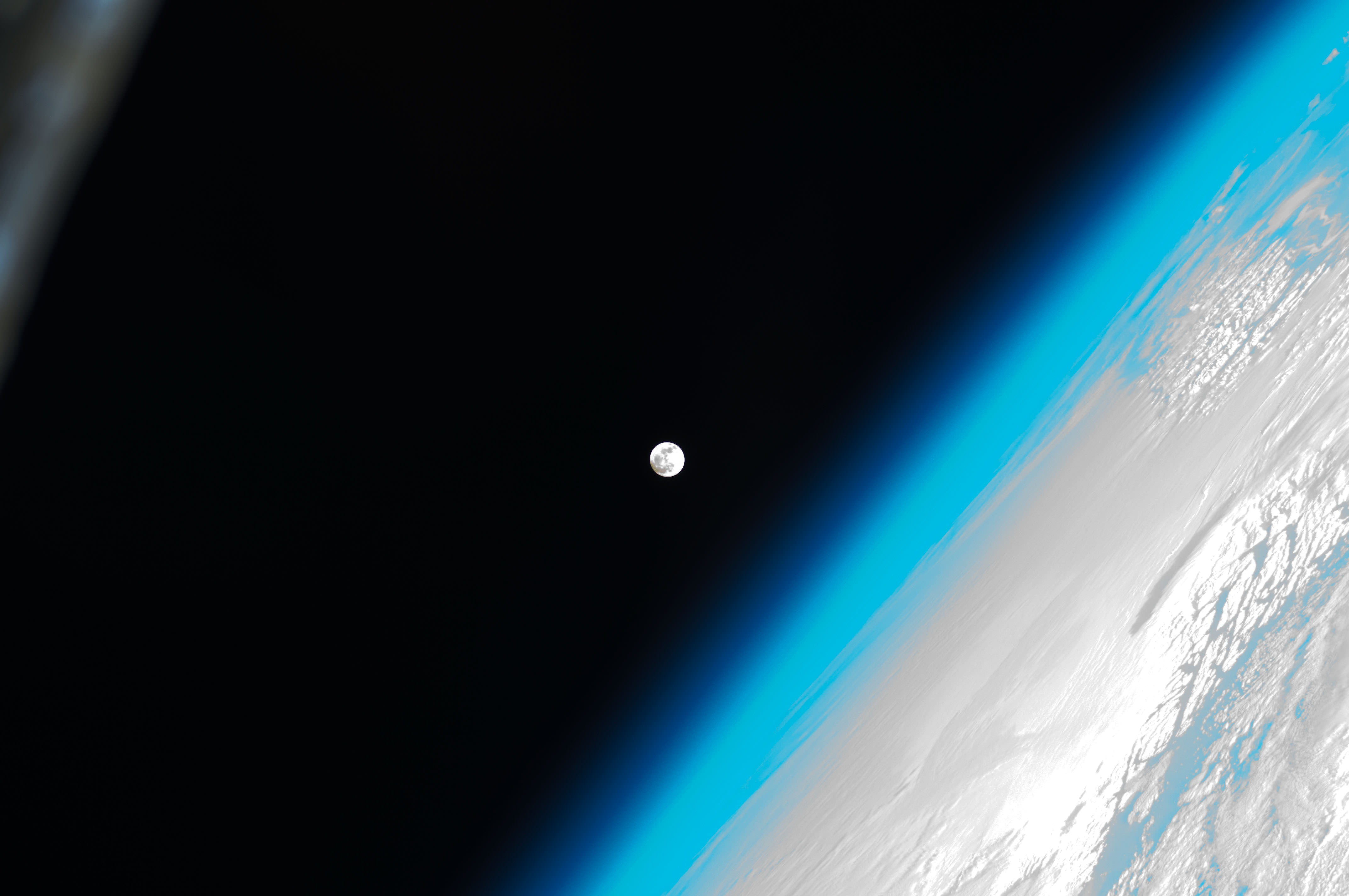
[/caption]
A lovely view for the start of your week: The Moon and Earth’s atmosphere as seen from the International Space Station, taken by a member of the current Expedition 30 crew. See more images from the crew here.
NanoRacks and CASIS Put Research on the Universe’s Front Porch
[/caption]
The Center for the Advancement of Science in Space (CASIS) has opened part of the ISS exterior to research experiments via NanoRacks, a company providing plug-and-play platforms aboard the Station to third-party research organizations. For the first time, commercial experiments will have a dedicated external space aboard the ISS, putting them on “the front porch of the Universe.”
Since 2009 NanoRacks has been providing research institutions with shoebox-sized consoles that can house customized experiments for installation inside the U.S. National Laboratory on board the ISS.
On April 12 CASIS announced a $1.5 million deal with NanoRacks that will allow an external “NanoLabs” platform to be installed on the Japanese Kibo module. The structure will provide research spaces up to 8″ square that will be exposed to the environment of space. (Watch a video of the NanoLabs concept below.)
Through the CASIS investment, as many as four companies will be able to fly experiments for little or no cost.
A formal solicitation to research companies and private enterprises for payload proposals will be issued by CASIS in June. The NanoLabs platform is expected to be ready for flight by 2013 — a full year ahead of schedule.
“CASIS’ investment ensures that U.S. researchers will have access to the ISS External Platform far sooner than otherwise expected,” stated Jeffrey Manber, Managing Director of NanoRacks . “This program will enable faster innovation and spiral development for payloads — an opportunity that has not previously been made available to the commercial marketplace.”
Read the full press release here.
NanoRacks LLC was formed in 2009 to provide quality hardware and services for the U.S. National Laboratory onboard the International Space Station. The company operates the first commercial laboratory in low-earth orbit. The Center for the Advancement of Science in Space (CASIS) was selected by NASA in July 2011 to maximize use of the International Space Station U.S. National Laboratory through 2020.
Image: S134-E-011413 — A backlit ISS photographed by the STS-134 crew of Endeavour on May 29, 2011, after undocking from the Station. (NASA)

